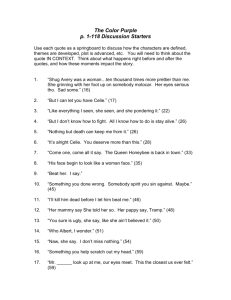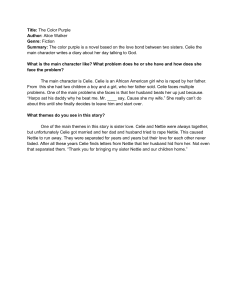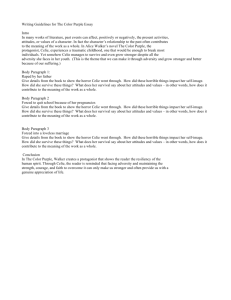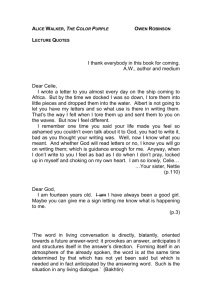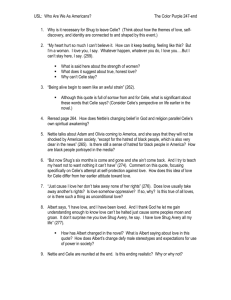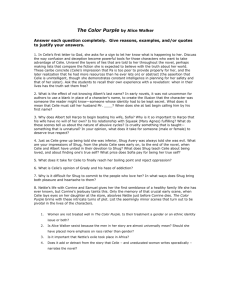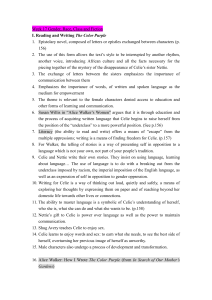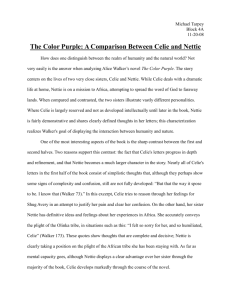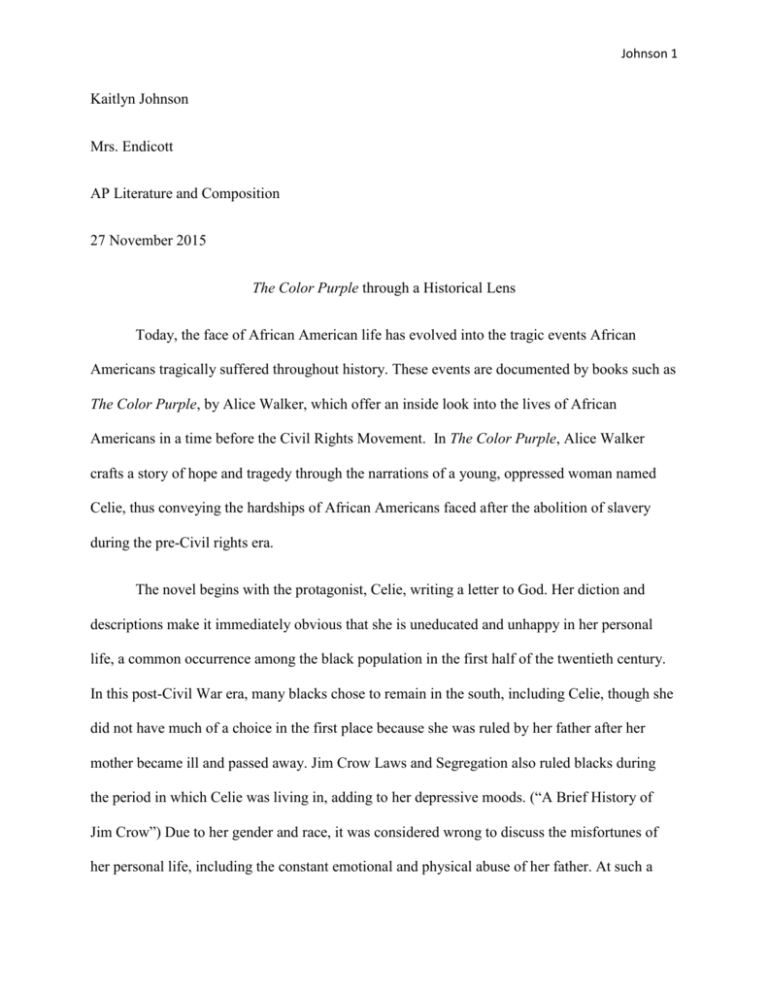
Johnson 1
Kaitlyn Johnson
Mrs. Endicott
AP Literature and Composition
27 November 2015
The Color Purple through a Historical Lens
Today, the face of African American life has evolved into the tragic events African
Americans tragically suffered throughout history. These events are documented by books such as
The Color Purple, by Alice Walker, which offer an inside look into the lives of African
Americans in a time before the Civil Rights Movement. In The Color Purple, Alice Walker
crafts a story of hope and tragedy through the narrations of a young, oppressed woman named
Celie, thus conveying the hardships of African Americans faced after the abolition of slavery
during the pre-Civil rights era.
The novel begins with the protagonist, Celie, writing a letter to God. Her diction and
descriptions make it immediately obvious that she is uneducated and unhappy in her personal
life, a common occurrence among the black population in the first half of the twentieth century.
In this post-Civil War era, many blacks chose to remain in the south, including Celie, though she
did not have much of a choice in the first place because she was ruled by her father after her
mother became ill and passed away. Jim Crow Laws and Segregation also ruled blacks during
the period in which Celie was living in, adding to her depressive moods. (“A Brief History of
Jim Crow”) Due to her gender and race, it was considered wrong to discuss the misfortunes of
her personal life, including the constant emotional and physical abuse of her father. At such a
Johnson 2
young age, Celie was able channel her emotions into her letters to God, and be able to look out
for the red flags heading her way.
As a result of these segregation laws, white males dominated society; they believed that
because they are white they automatically have power over blacks. In the story, when a strongheaded woman named Sophia was asked by the mayor’s wife, who is white, to be her maid,
Sophia responds, “Hell no,” (Walker 85). As quickly as the words were spoken, the mayor
slapped Sophia across the face without thinking twice. The sight of such a violent act was not
uncommon to people during that period, especially towards African Americans, and it was best
to look away and go about the day. Black males exerted dominance as well, but more harshly
because of the abuse they faced as a result of their skin color. In one of Celie’s letters to God she
explains, “Harpo ast his daddy why he beat me. Mr._____ say, Cause she my wife. Plus, she
stubborn. All women good for—he don’t finish. He just tuck his chin over the paper like he do.
Remind me of Pa,” (Walker 22). Not only did he beat her privately, but he forces her to get his
belt, then beats her in front of his children to humiliate her, to make her feel powerless. Celie is
clueless in how to stay strong in this situation, she says, “It all I can do not t cry. I make myself
wood. I say to myself, Celie, you a tree,” (Walker 22). After her endless years of abuse, Celie
becomes a master in channeling her pain into a different source. Obviously, there were no real
reasons for the beatings and abuse forced upon Celie by her father and her new husband, but the
habit is passed on down from generation to generation, and in this case it is being passed down
from Celie’s husband to his son, exactly like past generations.
In addition to the beatings and all the other negative events going along throughout
Celie’s and most African American’s lives, rape was one of the most common and most horrific
events at the time. (“Sexual Violence in the Lives of African American Women”) It was such a
Johnson 3
common occurrence people often thought nothing of it, showing just how much the world has
changed over time. The book is introduced by the speaker, a confused fourteen year old black
girl named Celie saying, “Dear God, I am fourteen years old. I have always been a good girl.
Maybe you can give me a sign letting me know what is happening to me” (Walker 1). A girl so
young and innocent has no escape from what is happening to her- she does not even know what
it is-but in her heart she knows it is wrong. “Then he push his thing inside my pussy. When that
hurt, I cry. He start to choke me, saying You better shut up and git used to it. But I never git used
to it” (Walker 1). By now, the readers know what tragic event is happening to Celie, she is being
raped by her father. At the time, rape was not against the law for blacks, but if it occurred in this
day and time, justice would be brought to the victim. A few years down the road, Celie is forced
into a marriage with Albert, a man who was in love with her sister Nettie. Her father forbid him
to have Nettie, but would give Celie to him along with her cow. Once again women are
dehumanized by men and treated as though they are animals. Most would guess that even though
she has been forced into a marriage, at least she is able to get away from the constant abuse she
is receiving at home, but that is quite the contrary. Celie walked into a new house with new
children to raise, a new house to clean, and a new man to take advantage of her, illustrating not
only the physical rape African American women faced, but the symbolic and mental rape as
well, as they were constantly violated and forced into horrible circumstances. (“Sexual Violence
in the Lives of African American Women”)
One of the most relatable events to today’s time is the rape that occurred in the prison to a
woman named Mary Agnes. When Mary Agnes returned from the prison, Celie described her
saying, “Poor little Squeak come home with a limp. Her dress rip. Her hat missing and one of the
heels come off her shoe.” (Walker 95) At this point, a woman’s dignity is stolen from her, and
Johnson 4
her life is changed forever. Mary Agnes’s husband referred to her as “Squeak” due to her shrill
voice, but also in a demeaning, mocking way, and of course it was acceptable for men to treat
women any way they wanted. After the terrible incident occurs, Celie voices one of the most
significant parts of Mary Agnes’s character when she finally stands up to her husband. “She
stand up. My name Mary Agnes, she say.” (Walker 97) This rape committed by white men
symbolizes the rape of African Culture; it was stolen, forced into silence, and killed them on the
inside.
The violence of whites did not stop with raping black women, but lynching became
another popular form of consequence and entertainment. (“Internet Encyclopedia of
Philosophy”) In the letters sent to Celie from her sister, Nettie, she describes the innocent life of
a black farmer who was actually making his way in the world. After prospering in all he grew,
the determined man tried his chance at selling goods in the new store he opened along with his
blacksmith shop. Unfortunately, the white merchants began talking that he was taking their
business. “And so, one night, the man’s store was burned down, his smithy destroyed, and the
man and his two brothers dragged out of their homes in the middle of the night and hanged”
(Walker 174-175). The result of a prospering life-much like many African Americans in that
time-was destruction and death. The whites could have simply burned down his store, bringing
the business back to theirs, but because the farmer had put any type of negative enforcement on
the whites, death was deemed appropriate. This sadly, became a common occurrence. As it turns
out, the murdered farmer was Celie’s biological father, not the one who continued abusing her
throughout her childhood. “My daddy lynch. Pa not pa.” (Walker 177) This does not commend
the tragic events happening to Celie, but it does, however, show the readers just how any black
person was chosen at random to be murdered.
Johnson 5
Through all of this, Celie continues her letters to God, showing the strength and extent of
her faith. During this early to mid-nineteen hundreds, most blacks were either Baptist or
Methodist due to the post-civil war development of religion for black people. These two
churches were the first to be accepted by whites as the “all black” churches. Before, whites were
against blacks having in type of religion at all because they believed it was a way to plot against
them, allowing them to escape slavery. The congregations were spread all over the United States
because although the two are different, they serve as culture-based religion. The Baptist and
Methodist churches fused together African and European forms of religion that reflected their
painful past. (“The Black Church,” a brief history) Thus, the churches continued to develop and
grow into what they are today.
The basis of African American culture, though painful, has changed tremendously over
the previous years. Being able to read a book specifically based on their culture and the
hardships many went through allows people to see how far we have come as a nation and be
thankful for sufferings many have went through in order to ensure their status now.
Johnson 6
Works Cited
""The Black Church," a Brief History." "The Black Church," a Brief History. Web. 29 Nov.
2015.
"A Brief History of Jim Crow." - Constitutional Rights Foundation. Web. 29 Nov. 2015.
"Internet Encyclopedia of Philosophy." Internet Encyclopedia of Philosophy. Web. 29 Nov.
2015.
"Sexual Violence in the Lives of African American Women." Sexual Violence in the Lives of
African American Women. Web. 29 Nov. 2015.

